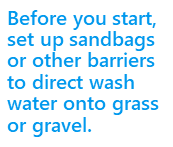Power Washing
To keep our waters clean keep your dirty water out.
Wash water from power washing activities may contain a large amount of oil, grease, chemicals, dirt and detergents. Disposing of these materials into storm drains causes serious ecological problems and is PROHIBITED by law. You could be given a citation or fined for discharging pollutants to the storm drain system.
Try it Dry
Instead of pressure washing, use dry methods such as mops, brooms, rags or wire brushes to clean pavement, buildings and equipment as much as possible.
Preparing for Power Washing
 Before you start, set up sandbags or other barriers to direct wash water onto grassy or gravel areas where the water will soak into the ground instead of run off
Before you start, set up sandbags or other barriers to direct wash water onto grassy or gravel areas where the water will soak into the ground instead of run off
into the road.
Just Enough for the Job
Minimize water by using high pressure, low volume nozzles. Use the minimal amount and least toxic detergents and degreasers you will need to get the job done. Use a mop or rags to clean heavily soiled areas before power washing.
Understanding “Biodegradable”
“Biodegradable” is a popular marketing term that can be misleading. Because a product is labeled as biodegradable does not mean that it is non-toxic. Some products are more toxic than others, but NONE are harmless to aquatic life. Soapy water entering the storm drain system will impact the aquatic environment in our local lakes, streams and rivers.
Washing Your Vehicle
Wash vehicles and equipment on grassy or gravel areas so that the wash water can seep into the ground. If the ground is very dry, wet it first so the wash water soaks in and does not run off into the storm drain.
Stormwater is rain or snowmelt and water from things people do, like overwatering the lawn or discharging pool water into the street drain. We can choose products carefully and shape our lawns and pavement so water sinks in. When we do, runoff is reduced, pollutants filter out and streams and groundwater are protected.
Untreated runoff is the biggest threat to our nation’s water quality, according to the U.S. Environmental Protection Agency. Let’s make the small, important changes that will reduce that threat and improve water quality and our lives!
